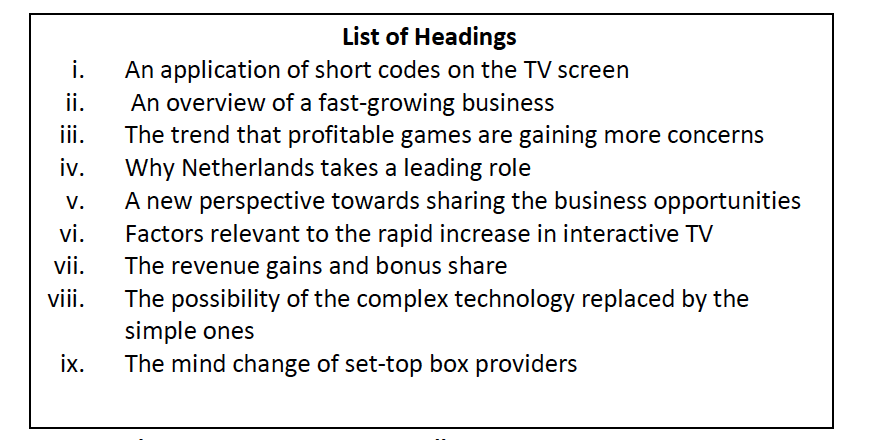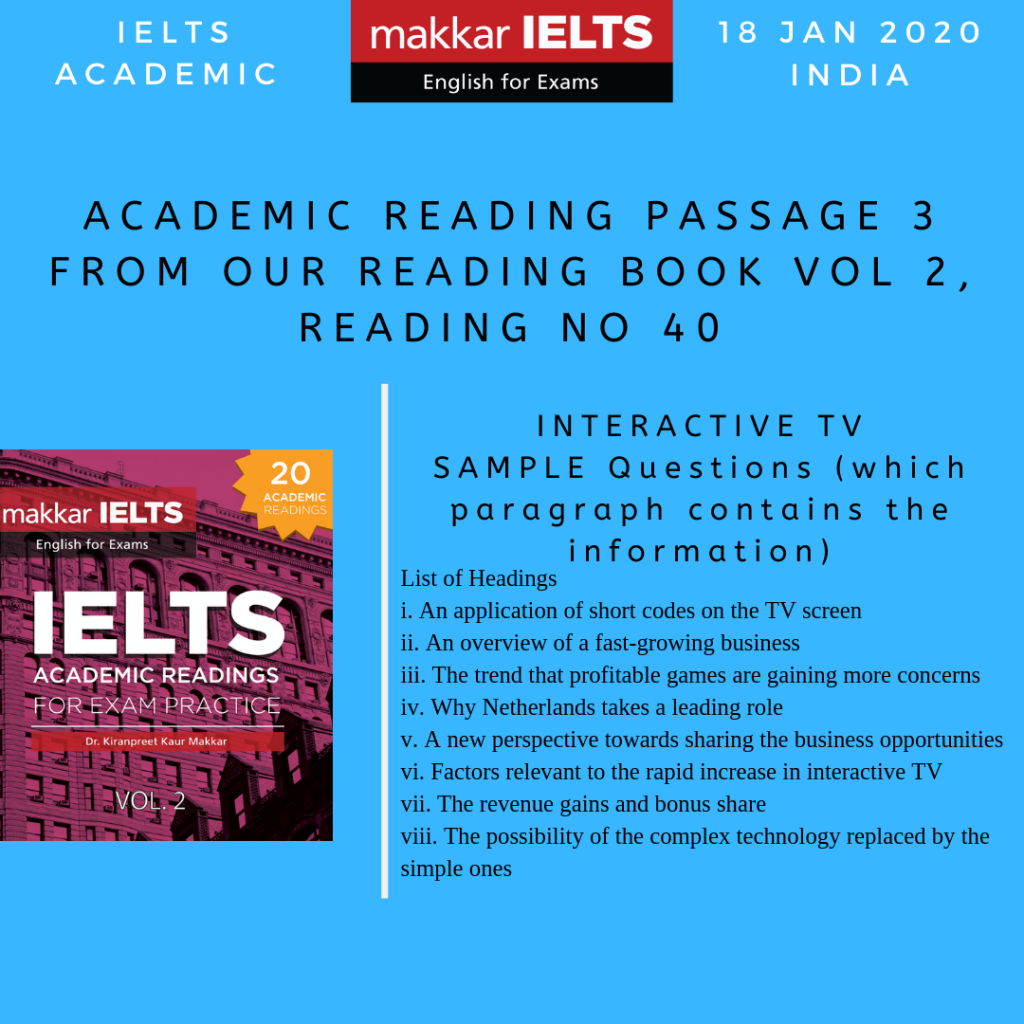READING PASSAGE 3
Questions 28-32
Reading passage 3 has seven paragraphs, A-G. Choose the correct heading for paragraphs A-G
from the list of headings below. Write the correct number, i-ix, in boxes 28-32.

Example: Section A: Answer ii
28. Section B
29. Section C
30. Section D
31. Section E
Example: Section F: Answer ix
32. Section G
INTERACTIVE TELEVISION
A. Once upon a time, if a television show with any self-respect wanted to target a young audience,
it needed to have an e-mail address. However, in Europe’s TV shows, such addresses are gradually
substituted by telephone numbers so that audiences can text the show from their mobile phones.
Therefore, it comes as no shock that according to Gartner’s research, texting has recently
surpassed Internet usage across Europe. Besides, among the many uses of text messaging, one of
the fastest-growing uses is to interact with television. The statistics provided by Gartner can
display that 20% of French teenagers, 11% in Britain and 9% in Germany have responded to TV
programmes by sending a text message.
B. This phenomenon can be largely attributed to the rapid growth of reality TV shows such as ‘Big
Brother’, where viewers get to decide the result through voting. The majority of reality shows are
now open to text-message voting, and in some shows like the latest series of Norway’s ‘Big
Brother’, most votes are collected in this manner. But TV-texting isn’t just about voting. News
shows encourage viewers to, comment by texting messages; game shows enable the audience to
be part of the competition; music shows answer requests by taking text messages; and
broadcasters set up on-screen chatrooms. TV audiences tend to sit on the sofa with their mobile
phones right by their sides, and ‘it’s a supernatural way to interact.’ says Adam Daum of Gartner.
C. Mobile service providers charge appreciable rates for messages to certain numbers, which is why
TV-texting can bring in a lot of cash. Take the latest British series of ‘Big Brother’ as an example.
It brought about 5.4m text-message votes and £1.35m ($2,1m) of profit. In Germany, MTV’s
‘Videoclash’ encourages the audience to vote for one of two rival videos, and induces up to 40,000
texts per hour, and each one of those texts costs €0.30 ($0.29), according to a consultancy based
in Amsterdam. The Belgian quiz show ‘1 Against 100’ had an eight-round texting match on the
side, which brought in 110,000 participants in one month, and each of them paid €0.50 for each
question. In Spain, a cryptic-crossword clue invites the audience to send their answers through
text at the expense of €1, so that they can be enrolled in the poll to win a €300 prize. Normally,
6,000 viewers would participate within one day.
At the moment, TV-related text messaging takes up a considerable proportion of mobile service
providers’ data revenues. In July, Mm02 (a British operator) reported an unexpectedly
satisfactory result, which could be attributed to the massive text waves created by ‘Big Brother’.
Providers usually own 40%-50% of the profits from each text, and the rest is divided among the
broadcaster, the programme producer and the company which supplies the message-processing
technology. So far, revenues generated from text messages have been an indispensable part of
the business model for various shows. Obviously, there has been grumbling that the providers
take too much of the share. Endemol, the Netherlands-based production firm that is responsible
for many reality TV, shows including ‘Big Brother’, has begun constructing its own database for
mobile-phone users. It plans to set up a direct billing system with the users and bypass the
providers.
D. How come the joining forces of television and text message turn out to be this successful? One
crucial aspect is the emergence of one-of-a-kind four-, five- or six-digit numbers known as ‘short
codes’. Every provider has control over its own short codes, but not until recently have they come
to realise that it would make much more sense to work together to offer short codes compatible
with all networks. The emergence of this universal short codes was a game-changer, because
short codes are much easier to remember on the screen, according to Lars Becker of Flytxt, a
mobile-marketing company.
E. Operators’ co-operation on enlarging the market is by a larger trend, observes Katrina Bond of
Analysys, a consultancy. When challenged by the dilemma between holding on tight to their
margins and permitting the emergence of a new medium, no provider has ever chosen the latter
WAP, a technology for mobile-phone users to read cut-down web pages on their screens, failed
because of service providers’ reluctance towards revenue sharing with content providers. Now
that they’ve learnt their lesson, they are altering the way of operating. Orange, a French operator,
has come such a long way as to launch a rate card for sharing revenue of text messages, a new
level of transparency that used to be unimaginable.
F. At a recent conference, Han Weegink of CMG, a company that offers the television market textmessage
infrastructure, pointed out that the television industry is changing in a subtle yet
fundamental way. Instead of the traditional one-way presentation, more and more TV shows are
now getting viewers’ reactions involved.
Certainly, engaging the audiences more has always been the promise of interactive TV. An
interactive TV was originally designed to work with exquisite set-top devices, which could be
directly plugged into the TV. However, as Mr Daum points out, that method was flawed in many
ways. Developing and testing software for multiple and incompatible types of set-top box could
be costly, not to mention that the 40% (or lower) market penetration is below that of mobile
phones (around 85%). What’s more, it’s quicker to develop and set up apps for mobile phones.
‘You can approach the market quicker, and you don’t have to go through as many greedy
middlemen,’ Mr Daum says. Providers of set-top box technology are now adding texting function
to the design of their products.
G. The triumph of TV-related texting reminds everyone in the business of how easily a fancy
technology can all of a sudden be replaced by a less complicated, lower-tech method. That being
said, the old-fashioned approach to interactive TV is not necessarily over; at least it proves that
strong demands for interactive services still exist. It appears that the viewers would sincerely like
to do more than simply staring at the TV screen. After all, couch potatoes would love some thumb exercises.
Questions 33- 35
Choose the correct letter A, B, C or D. Write the correct letter in boxes 33-35 in your answer sheet.
33. In Europe, a research suggests that young audiences spend more money on
A. Thumbing text messages
B. Writing emails
C. Watching TV programs
D. Talking through mobile phones
34. What would happen when reality TV shows invite the audience to vote?
A. Viewers would get attractive bonus
B. They would be part of the competition
C. Their questions would be replied
D. Their participation could change the result
35. interactive TV will change from concentrating on set-top devices to
A. increasing their share in the market
B. Setting up a modified set-top box
C. Building an embedded message platform
D. Marching into the European market
Questions 36 to 40
Look at the following descriptions on the list of companies below. Match each description with
the correct company A-F
Write your answers in boxes 36 to 40 on your answer sheet
List of companies
A. Flytxt
B. Analysys
C. Endemol
D. CMG
E. MmO2
F. Gartner
36. Offered mobile phone message technology
37. Earned considerable amount of money through a famous program
38. Expressed the view that short codes are convenient to remember when turning up
39. Built their own mobile phone operating applications
40. Indicated that it is easy for people to send message in an interactive TV
28. VI
29. VII
30. I
31. V
32. VIII
33. A
34. D
35. C
36. D
37. E
38. A
39. C
40. F



Can anyone describe the ans of matching headline. I think there answers are wrong. Help me.
Thankyou sir, it helped me and please provide me anothrr two passages of this date
Dear Makkar,
Thank you for sharing but I am very surprised by the answers esp 28 to 32.
Are these answers all correct.? Very difficult to understand.
The paragraph is saying totally different and the heading as answers that you mentioned are totally different.
Please revert
Thank you